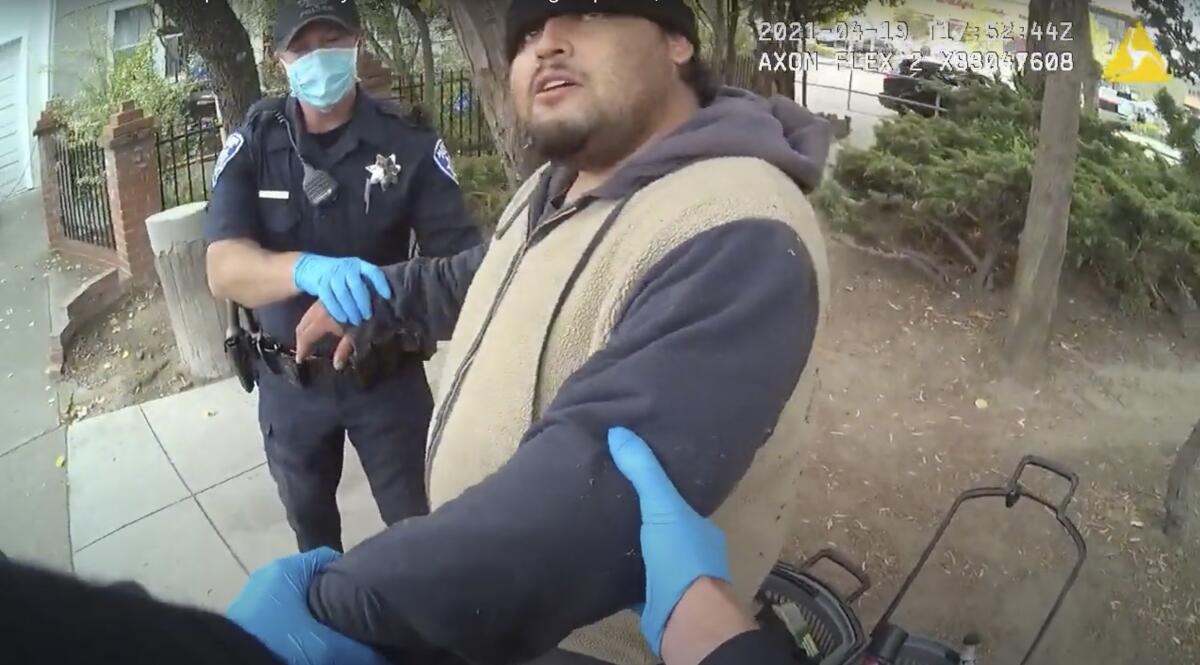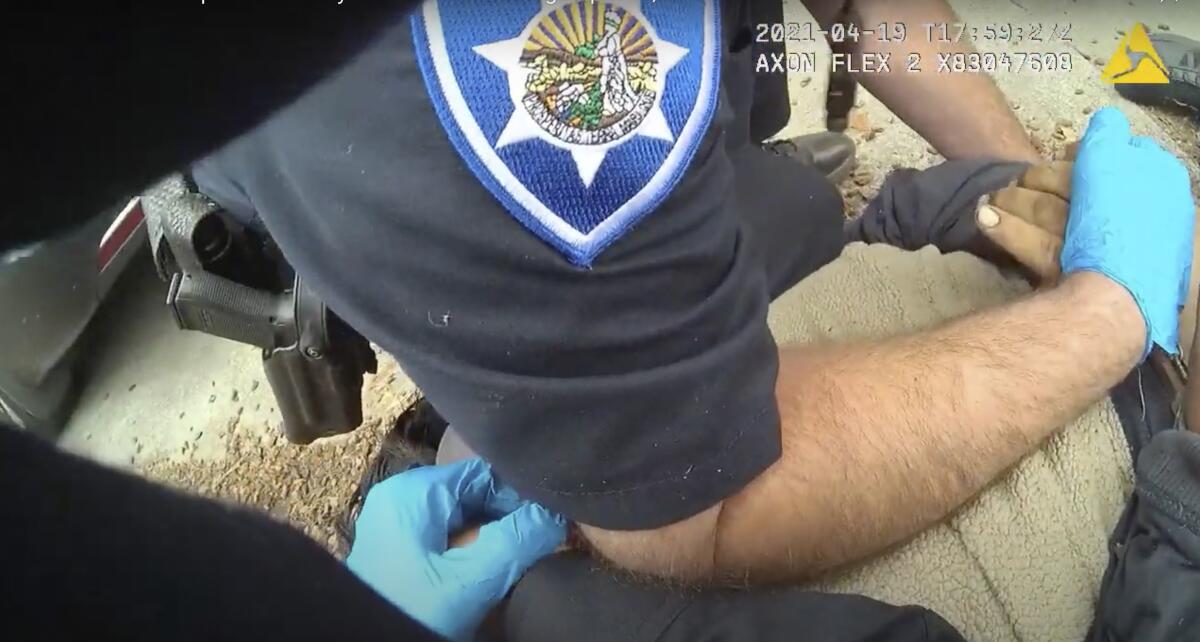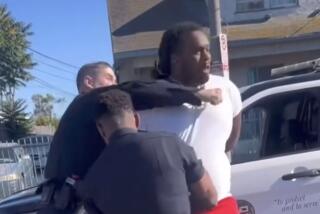Outrage grows as new video shows Latino man dying after Bay Area police pin him for 4 minutes

- Share via
In a case drawing comparisons to the killing of George Floyd, authorities in the Bay Area city of Alameda are facing growing outrage after a body-camera video showed a police officer appearing to put a knee on the back of a 26-year-old Latino man for more than four minutes as he gasped for breath and eventually died.
The incident has drawn scrutiny in part because the man who died, Mario Gonzalez, appeared to pose no imminent threat to the officers when they arrived at a local park on April 19 after calls about an intoxicated man and a possible theft.
One of the 911 callers told a dispatcher: “He seems like he’s tweaking. But he’s not doing anything wrong, he’s just scaring my wife.”
A second caller told a dispatcher about a man with a Walgreens basket with alcohol and “it looks like he is breaking off the security tags.” That caller added that the man had been loitering for half an hour.
Some law enforcement experts said the video raises serious questions about police tactics.
“There is going to be a very intensive inquiry on this,” said Ed Obayashi, a Northern California sheriff’s deputy, legal advisor and veteran police trainer. “It is rare that a non-threatening, non-belligerent person ends up dying like this. ... What was the officers’ justification for detaining him? This individual was not a threat to the officers.”
The nearly hourlong video from two officers’ body cameras shows police talking to Gonzalez in a park. In the video, Gonzalez seems dazed and struggles to answer officers’ questions.
Gonzalez wouldn’t produce any identification, so the officers try to force his hands behind his back to handcuff him, but he does not let his arms go limp. The officers determine that he is resisting, then push him to the ground, the video shows.
The officers, as they seek to restrain him, repeatedly ask Gonzalez for his full name and birth date.
“I think you just had too much to drink today, OK? That’s all,” an officer says. After learning his name, the officer adds, “Mario, just please stop fighting us.”
Gonzalez, who weighed about 250 pounds, by that point is lying facedown on some wood chips and can be heard shouting and grunting as the officers use their body weight to control him. One officer appears to put an elbow on his neck and a knee on his shoulder.
“He’s lifting my whole body weight up,” an officer tells his colleague.
One officer puts his knee on Gonzalez’s back for four minutes or more.
Gonzalez is heard in the video telling officers, “I didn’t do nothing, OK?”
Shortly before Gonzalez stops breathing, one officer asks the other, “Think we can roll him on his side?” but the other answers, “I don’t want to lose what I got, man.”
Another officer then asks, “We got no weight on his chest?” then repeats, “No! No weight ... no weight.”
“He’s going unresponsive,” one officer says.
The officers roll Gonzalez over and perform cardiopulmonary resuscitation, but he was later pronounced dead at a hospital.
The Alameda County coroner’s office is conducting an autopsy to determine a cause of death. Gonzalez’s death is under investigation by the Alameda County Sheriff’s Office and the county district attorney’s office.
The city of Alameda on Wednesday identified the three officers placed on leave during the investigation into Gonzalez’s death as James Fisher, Cameron Leahy and Eric McKinley.
Fisher has been with the department since 2010. Leahy joined the force in 2017, and McKinley in 2018.
The city did not describe each officer’s role in the incident captured on video.
Civilian parking enforcement employee Charlie Clemmens was also involved in the incident, the city said.
Julia Sherwin, an attorney for Gonzalez’s family, said the young man’s death was “completely avoidable.”
She said officers should never have laid hands on him, let alone put him prone on the ground and push down on him — something that law enforcement officers should know creates “a very high risk of death by restraint asphyxiation.”
“It was a complete violation of all generally accepted law enforcement policies and training,” said Sherwin, who has 20 years of experience handling wrongful death cases. “And these horrible tactics employed by the officers on the scene don’t come out of nowhere. They grow out of bad training and supervision.”
The family wanted all the body camera footage released, as well as any surveillance footage that captured the incident, she said. They were in favor of “full transparency” and wanted Mario’s face shown, but authorities obscured his face in the video anyway, she said.
Based on the footage, she said it appeared Mario Gonzalez may have been intoxicated — but, she said, the price he paid was completely disproportionate to that minor offense.
“We don’t kill people for being drunk in a park in the United States,” she said. “We don’t kill people for being suspected of having possibly stolen two bottles of alcohol, and we don’t kill people for passively resisting law enforcement when they’re unarmed and no threat whatsoever. And yet Mario’s dead.”

Gonzalez’s family says it was a clear case of excessive force on a man who had no idea why officers were detaining him.
“The police killed my brother, in the same manner they killed George Floyd,” his brother Gerardo Gonzalez told reporters Tuesday.
“He’s a lovely guy. He’s respectful, all the time,” said Mario’s mother, Edith Arenales. “They broke my family for no reason.”
While a cause of death has not been established, law enforcement training experts said Gonzalez could have been asphyxiated by the officer’s knee.
“This is another tragic incident of compression asphyxia,” Obayashi said. “Officers have to be able to recognize compression asphyxia. We have had too many deadly incidents like this one.”
Seth Stoughton, a University of South Carolina law professor and a former Florida police officer, said “the dangers of positional asphyxia” have been well known in policing and incorporated into training since the early 1990s.
The technique should especially be avoided when there are risk factors like obesity and drug or alcohol use, as was true in this case, he said.
He likened the situation to a boa constrictor killing its prey by depriving it of oxygen.
Stoughton, who has written about police training and force extensively, said it is acceptable for officers to place someone prone on the ground for a short period of time to put on handcuffs.
There was no need to pile on Gonzalez to arrest him, Stoughton said.
But Charles “Sid” Heal, a former Los Angeles County sheriff’s commander and use-of-force expert, said he did not see a problem with the officers’ actions.
“The suspect is in a continual state of resistance and defiance,” Heal said. “The officers actually plead with him not to resist. I suspect he is under the influence of some drug and is going to die from either the drug or excited delirium.”
Last summer, then-Minneapolis Police Officer Derek Chauvin pinned Floyd’s neck for more than eight minutes as Floyd gasped, “I can’t breathe.” Chauvin was convicted of murder last week — a day after Gonzalez’s death.
After watching the video, George Galvis, executive director of Communities United for Restorative Youth Justice, said he wants the officers to be criminally prosecuted.
Gonzalez’s younger brother, Jerry, receives mentoring from the organization, which is serving as an advocate for the family, Galvis said.
Gonzalez had a four-year-old son, also named Mario, and was the main caretaker for his mother and an autistic brother, Efrain, according to a GoFundMe.
Communities United for Restorative Youth Justice was involved with the successful effort to change the state standard of police use of lethal force from reasonable to necessary, Galvin said.
On Saturday, the organization will hold a rally to demand that Alameda Dist. Atty. Nancy O’Malley bring murder charges against the officers.
“The fact that he was not combative, the fact that he was not violent, the fact that he had not committed a crime, proves that this was not necessary,” Galvis said.
This is the video released by police. Caution: It is graphic.
More to Read
Sign up for Essential California
The most important California stories and recommendations in your inbox every morning.
You may occasionally receive promotional content from the Los Angeles Times.











